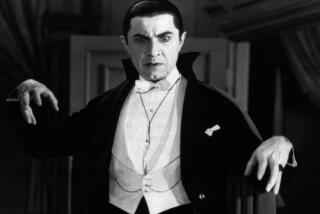MOVIE REVIEW : A TV Freak You Can’t Escape in ‘Shocker’
- Share via
Wes Craven’s “Shocker” (citywide) is a horror thriller about media technology infiltrated by a hellish maniac, an insane TV repairman named Horace Pinker (Mitch Pileggi), who converts himself into the phantom of the airwaves, leaping from TV to TV, program to program, body to body.
Pinker--like Craven’s earlier villain, Freddy Krueger of the “Nightmare on Elm Street” series--is a monster you can’t get away from. In his human incarnation, he uses his job to gain entry to houses--his repair van is emblazoned “We Do It in Your Home”--and slaughters whole families. After he’s caught and electrocuted, two events that barely faze him, he becomes something worse: the devil that steals souls and rides in electrical currents, the monster that hides in your TV, the demon of the media.
Obviously this is a symbolic, satiric idea, and a good one. Craven is working over our paranoia of the media and especially TV: the way it manipulates us, takes over our lives, and the endless cornucopia of horrors--wars, crimes, disasters--that pour through its receivers. When we first see Pinker, he’s a pair of disembodied hands working over some TV innards. The sets in his horror-gallery of a shop are always turned to riots, war or nuclear blasts. And when the movie’s hero, quarterback Jonathan Parker (Peter Berg), fights him, he sometimes uses TV aerials, like a vampire hunter waving a cross. The movie suggests that the devil controls television and it also hints, bemusedly, that the only way to fight this scourge is with dreams, purity, love--and a handy channel-changer.
Craven, like David Cronenberg or George Romero, is a real virtuoso of lower-case horror, and “Shocker” is crammed with dazzling bursts of macabre technique. There’s that couch-potato’s nightmare: the moment when a reclining chair suddenly comes alive, possessed with Pinker, and tries to strangle Jon as he watches TV, or the shots of hero and villain diving in and out of sets, or the “Vertigo”-style chase on the station tower. Eeriest of all is one dream sequence where Jonathan passes a TV with a still shot of gray, endless rain and enters a bathroom where one wall has become a shower curtain concealing grisly secrets.
However, it’s in those dreams, strung through the entire movie, where “Shocker” goes wrong. Ever since he directed the first “Nightmare on Elm Street” in 1984, abandoning the sequels to others, Craven may be haunted by the fact that he made what many regard as the single scariest genre horror movie of the decade.
Since then, he keeps brewing up new bad dreams in different films, but he’s never put them into as taut and compelling a structure as “Nightmare.” “Shocker” is so diffusely organized it’s almost three separate movies. The first: a fairly standard if stylish and over-gruesome slasher movie. The second: a dubious if hair-raisingly funny reprise of Jack Sholder’s “The Hidden”--with Pinker taking over one body after another. The third, the best and most imaginative, mixes up multi-plane nightmares with a modern variation on Buster Keaton’s man-into-movie farce “Sherlock Jr.” It’s in the midsection that the symbolism breaks up completely. Pinker becomes a different kind of monster: controller of bodies and not electronics.
As in most horror movies, the gore--suggested more than emphasized--and dark, raw jokes may drive away sensitive audiences. And the visuals tend to swallow up the actors, though Pileggi has moments of horrific hamminess, Timothy Leary pops up as a greed-crazed televangelist and the usually impeccable Michael Murphy gets a rare chance to roll his eyes and go berserk. But there’s already a genre horror classic on TV paranoia, Cronenberg’s “Videodrome,” and “Shocker” (MPAA-rated R, for sex, language and violence) neither matches it nor Craven’s own best. Maybe it’s time he forgot about telling us his dreams, or simply took over the “Nightmare” series again, and let them run wild.
‘SHOCKER’
A Universal release of an Alive Films presentation. Director/script/executive producer Wes Craven. Producers Marianne Maddalena, Barin Kumar. Camera Jacques Haitkin. Editor Andy Blumenthal. Production design Cynthia Kay Charette. Music William Goldstein. Costume Design Isis Mussenden. Co-executive producer Shep Gordon. With Michael Murphy, Peter Berg, Cami Cooper, Mitch Pileggi.
Running time: 1 hour, 50 minutes.
MPAA rating: R (under 17 requires an accompanying parent or adult guardian).
More to Read
Only good movies
Get the Indie Focus newsletter, Mark Olsen's weekly guide to the world of cinema.
You may occasionally receive promotional content from the Los Angeles Times.










